PROVINCETOWN — WOMR, the Outer Cape’s community radio station, is set to lose almost 20 percent of its annual revenue following the elimination of federal funding for the Corporation for Public Broadcasting (CPB).
WOMR
RADIO
DJ Fred Wants to Open Your Ears
Fred Boak invites his listeners to ‘get on the bus’
Fred Boak played Terry Riley’s “Descending Moonshine Dervishes” one deep-winter Wednesday night on his WOMR radio show Out There. Riley’s intricate 1975 recording on the organ, which could be considered jazz or ambient music, is arresting. It lasts 45 minutes and features a looping delay Riley called a “time-lag accumulator.”

DJ Fred, as Boak is known on the air, has eccentric tastes. He recently played the song “Let’s Go Fly a Kite” from Mary Poppins, performed by Sun Ra, and he injects spirituality into the Outer Cape’s mostly secular Sundays during his Gospel Brunch Hour. He plays songs you want to share with friends, which is what Boak feels when he’s in the DJ booth. “I’m trying to be the listener’s friend,” he says. “I’m not trying to explain the music. I’m like, ‘Did you hear that?’ ”
Out There features jazz, loosely defined, on the second and fourth Wednesdays of the month from 9 p.m. to midnight. Boak’s Omnipop Omnibus, on alternate Sundays from 1 to 4 p.m., features a wide range of music and begins with Gospel Brunch Hour.
Boak sings with the Chandler Travis Philharmonic, a nine-person ensemble, and the Three-O, a smaller group of Philharmonic musicians. The roles of DJ and performer “inform each other,” he says. “They both satisfy that itch of being able to share all kinds of music.” Boak often performs wearing pajama pants and sporting a red plastic vuvuzela horn. He describes the Philharmonic’s music as “omnipop,” “alternative Dixieland,” and “gospel music for atheists.”
Offstage, Boak lives a quiet life working remotely as a computer programmer from the home in Orleans he shares with his “sweetheart,” Naomi Rush. The two also share an affinity for art collecting (described in a December 2024 article in the Independent.)
Boak moved to the Cape from Boston in 2000 with his then-wife when it looked like their Coolidge Corner apartment was going to go condo. He had his eye on the Maine coast, but after visiting the Outer Cape and seeing a performance at the Beachcomber by the Incredible Casuals (another Chandler Travis band), he realized the Cape had more to offer than the “craziness” he associated with his visits to Hyannis. Boak began regularly performing with Travis in 2004 after hanging around the band long enough to be assigned to sell merch.
Boak was recruited to join the WOMR board in 2012. He hadn’t DJed since the 1980s — he did a few graveyard shifts at the Marist College station while he was home from M.I.T., where he was a student, and bristled at requirements to play Top 40. Answering phones during a WOMR pledge drive in 2015, he started to imagine his own show.
That became the Gospel Brunch Hour. Boak kicks off his Sunday shows with “Son of a Preacher Man,” the 1969 song by Dusty Springfield. It’s a nod to Boak’s background: his father was a minister at Freedom Plains Presbyterian Church in Poughkeepsie, N.Y., where Boak grew up. Boak sang in the choir, but it wasn’t gospel. “Once in a while, we’d sing an old spiritual,” he says, “but we’d be very white about it.” It wasn’t until the early days of CDs, when a Mahalia Jackson reissue caught his ear, that he began listening to gospel music. He moved on to the Holmes Brothers and started listening to the long-running radio show Sinner’s Crossroads, billed as “homemade congregational tapes and vintage commercial gospel throw-downs, a little preachin’, a little salvation, a little audio tomfoolery” on the New York City and Hudson Valley station WFMU.
Identifying somewhere between “lapsed Christian” and “secular humanist,” Boak says he’s drawn more to the positive message of gospel music than its religiosity. “There’s something about the message of love and peace that’s special,” he says.
The rest of Boak’s Sunday program is “omnipop” or “pan-rock and roll,” recalling the rock stations he listened to growing up in the Hudson Valley, like WPDH. “It was the mid-to-late-’70s FM heyday,” he says. “Tom Waits and the Roches and Peter Gabriel and Genesis and Led Zeppelin and the Beatles. Everything got played.”
He credits the band NRBQ with the term “omnipop,” describing their own broad-ranging sound. “Omnibus,” he says, is an invitation to “get on the bus.”
Boak’s other show, Out There, evolved from a modern jazz show, Miles to Go, that had the same time slot. Boak filled in occasionally, and when the slot opened up, he put in a request for his own show with his own spin in a more avant-garde direction.
Boak also credits NRBQ with introducing him to avant-garde music. He’d been a fan of the band for years but started going to more of their shows in the 1990s. “They sort of took things to another level,” he says.
One of Boak’s favorite things about being a DJ is the way that it leads him to find music he hasn’t heard before. He guesses that he spends about as many hours preparing for each program as he spends on the air, searching for new music and combing through his collection for topical songs.
“I’ll come up with some silly theme, and I’ll go through my collection and find every song that relates to that,” he says. “I did a half hour of music about breathing and air. I hope it opens my listeners’ ears.”
RADIO
Traversing the Seas of Recollection
WOMR’s Erik the Red is a storytelling DJ
Eric Auger doesn’t always wear his horned helmet. On air, Auger is Erik the Red, the Viking skipper of his WOMR show, The Reminiscence Bump, every other Thursday from 9 p.m. to midnight. He’s had the show for a year and a half.

The “reminiscence bump” is an actual phenomenon: the National Library of Medicine defines it as “a tendency for middle-aged and elderly people to access more personal memories from approximately 10-30 years of age.”
“Music imprints on young adults,” says Auger. “It’s part of your evolution as a person. Everybody loves music from when they were that age.” Each show has three ingredients: a memory, a story, and a song. Auger remembers his art teacher, Mr. D, who loved Barbra Streisand. “I was a 13-year-old boy listening to ‘Woman in Love’ while I was painting,” says Auger. The playlist evolves from there: songs that feel like that memory.
On Feb. 6, the week before Valentine’s Day, Auger told the story of an ex-boyfriend showing up at his house, banging on the door. When Auger opened it, the ex stormed to his car, put on “Love Is a Battlefield” by Pat Benatar, and proceeded to drive up and down the street blasting the song. That night’s episode of The Reminiscence Bump was called “Lost in Love.” Auger played “Love Is a Battlefield” and other songs about relationships, “good, bad, sad, and glad.”
Auger grew up in rural Burrillville, R.I. in a family inclined to the arts. “My dad was a wood carver,” he says. “My mom was a seamstress.” Auger is the youngest of four, all of whom drew and painted. When he was 11, he started to collect vinyl. He listened to new wave, post punk, pop, rock and roll. Auger was a gay kid in a small town in the ’80s — “Music was my escape,” he says, from a place where he knew no other gay people. “I had a lot of questions and confusion about myself. I let the tunes take me away.”
Auger graduated in 1992 from Rhode Island College with a degree in photography and graphic design. He started as a radio and television production major, so in a way he’s come full circle, he says. In Pawtucket, R.I., he and a business partner, Joe Pari, started TEN31 Productions, a performance art company that specializes in “living artwork and dance” for events. Auger still co-owns and runs the company remotely from Provincetown, where he moved in 2020 with his husband, Joe Asermely.
How was Erik the Red born? “My dad loved Vikings,” says Auger. “He named me Eric after Erik the Red.” The real Erik the Red was a Norse explorer credited in medieval sagas with founding the first European settlement in Greenland. “I do have a little bit of Norse blood in me,” says Auger.
The DJ is a Viking, but the show doesn’t stick to Scandinavian sounds. “I love country,” says Auger. “I love rap, pop, rock, soul, gospel. I like soundtracks and musicals. I wanted to do something about how music makes me feel.” The common thread thoughout all genres he plays is nostalgia.
Auger says he’s learned a lot since joining WOMR — about the technical aspects of radio but also about himself. “I’m actually an introvert,” he says. That fact isn’t obvious: in the summer, he performs a one-man show on Commercial Street as characters like Penguin from Batman, Beetlejuice, or Nosferatu, singing into a microphone. “Sometimes I’ll dress up as Satan,” he says, “just to be crazy.” One of his characters is called Bob the Goat. “He’s just a goat.”
Dressed up, “I have my facade on — it’s almost like my armor,” Auger says. As a kid, he looked forward to Halloween. His costuming has become more elaborate and immersive in adulthood. When planning his radio show, Auger had to ask himself: “Do I have the courage to put myself out there and share my stories as Eric?”
The answer is yes. “I’m totally myself,” says Auger. WOMR has given him “free rein,” he says, to play make-believe. “Why adults can’t play anymore is beyond me. I refuse to believe that.” Around Christmas, Auger has “conversations” with Santa Claus. At Halloween, he rolls his “r”s, cackles, and becomes a vampire. Always, he’s Erik the Red — the version of Eric Auger that is a storytelling DJ.
Last year, for St. Patrick’s Day, Auger told a story about his mother’s Irish friend Kitty Duffy, who called often. “I’d pick up the phone,” he says. “She’d say, ‘Oh, hello there, Eric! Do you happen to know who might be calling?’ ” His mother had only one friend from Ireland, and Kitty’s accent was thick. He’d say, “Is it Kitty?” and she’d say, “How’d you guess?”
Auger told the tale in an Irish accent. A listener called and told him the story had made her laugh. “Your Irish brogue was perfect,” she said. Later, at a WOMR anniversary party, the caller recognized him, and the two, meeting for the first time, hugged. “That’s what it’s all about,” says Auger.
On air, Auger invites listeners to tell their own stories. “It shocks me when people call in,” he says, because his show is late at night. But people of all ages do. “They’ll call in and say, ‘I have a bump for you!’ As long as I know one or two people were tuning in, and I gave them happiness, then my mission is accomplished.”
RADIO
Listening to Everything
Indira Ganesan lets the music speak for itself
When Indira Ganesan was a WOMR DJ in the 1980s, she was reprimanded by the program director for playing tracks that he deemed too raucous. “All the early morning shows were called ‘First Light,’ which meant a gentle rise to the day,” she says. But she would play songs like “Love Shack” by the B-52s. After several warnings, Ganesan says, she relented and began adding folk and Brian Eno to her playlists.

Ganesan is still working an early morning shift. Her show, which airs on Sundays from 6 to 9 a.m., is now called Namaste, a Sanskrit greeting associated with yoga and Hinduism. Though the show’s name suggests music from South Asia, Ganesan doesn’t limit herself geographically or by genre. Her playlists include artists she grew up listening to as well as suggestions listeners email to her. The result: a medley of just about every type of music there is.
Her Feb. 2 show featured melancholy folk-rock songs by Marianne Faithfull, country-pop tunes by Beyoncé, and atmospheric, jazzy tracks by Pakistani-American artist Arooj Aftab, among others. Each song flowed into the next without fuss, despite their stylistic differences.
Ganesan was born in Srirangam (now part of the city of Tiruchirappalli) in South India. Her family moved to the U.S. when she was five, and she grew up in St. Louis and Spring Valley, N.Y. At home, the radio was always on. Her favorite rock DJs on WNEW in New York were Dennis Elsas and Pete Fornatale. “I was a radio nerd,” she says. “I was the kid at the party reading liner notes near the stereo.”
After graduating from high school, Ganesan returned to India and spent a year at Stella Maris College in Chennai (previously called Madras). “My high school friends taped a dozen cassettes for me to listen to,” she says, including Bob Dylan’s Blonde on Blonde and Joni Mitchell. She came back to the States to get a bachelor’s degree at Vassar and a master’s at the Iowa Writers’ Workshop.
From 1984 to 1986, Ganesan was a writing fellow at the Fine Arts Work Center. It was there that she finished her first novel, The Journey, published by Alfred A. Knopf in 1990. She stayed in town for another year to work as a secretary for artist Myron Stout. He was visually impaired, and she read to him from art magazines.
That was when Ganesan, now 64, got her first gig as a DJ. Her friend Kathy Shorr had a morning show at WOMR, and Ganesan had recently gotten her radio license. When Shorr gave up her show, Ganesan says, she took over the slot. “It was probably the most exciting thing I’d ever done,” she says.
A year later, a friend in New York City invited her to come there and she moved to Staten Island and worked as a proofreader for a graphic design firm. For the next 30 years, she traveled around the country, teaching creative writing in M.F.A. programs at the University of Missouri, the University of California in San Diego and Santa Cruz, Long Island University, Naropa University, and the University of Colorado Boulder.
In 2011, Ganesan moved back to Provincetown. She’s published two more novels: Inheritance and As Sweet As Honey, both with Knopf. Now she’s working on poetry and two more novels while teaching part-time, remotely, at Emerson College. “One of the first things I did when I got back to town,” she says, “was go to the radio station and ask if I could volunteer.”
She’s been making a playlist for her next show. “I’m going to have some Led Zeppelin,” she says — but it turns out to be covers by Rodrigo y Gabriela, a duo from Mexico. “They play a great ‘Stairway to Heaven,’ ” she says. “As does this ukelele player from Hawaii, Jake Shimabukuro. That reminds me a little bit of the band Santana.” As Ganesan assembles the artists, “it all kind of flows together.”
“I’m interested in the way musicians honor each other,” she says. “You’ll get a Japanese band that’s really good at surf guitar. You’ll have a samba musician playing the Beatles, or the Beatles asking Ravi Shankar to help them with sitar.”
Shankar, the renowned Indian sitarist, and his daughter Anoushka are two of Ganesan’s “stalwarts” on her show, she says. But “in a kind of reverse osmosis,” she says, “I didn’t start out listening to Indian music.” It was on in the background at home, but she “tuned it out.” Instead, she listened to the Beatles. “But then I found out that the Beatles listened to Ravi Shankar,” Ganesan says.
Now, she always starts her show with classical Eastern music, with string instruments like the sitar and oud and percussion like the tabla. “I go from there to jazzy fusion and eventually to rock and roll,” she says.
On the air, she says little between songs. “I’m a real believer in not talking too much,” she says, “and just letting the music speak for itself.” Sometimes she’ll play recordings of musicians talking about their music. In a 1971 performance by Shankar in Copenhagen, “Nine Decades, Vol. 7,” he explains that he’ll begin with an evening raga. A raga is a traditional Indian classical melodic framework that musicians may improvise on.
“First you will hear a short solo on the sitar,” says Shankar, “followed by a cut. That’s where the drums join — the tablas, in a rhythmic cycle, known as Rupak Taal, of seven beats.” The sitar sings out with its characteristic mournful twang. Then, as Shankar says, the tablas come in, spelling out a seven-beat pattern. The music is complicated and beautiful — made more so because the audience has an idea of the piece’s inner workings.
Later in the performance, Shankar introduces each instrument that’s onstage — the sitar made of teakwood with its six principal strings and 13 sympathetic strings; the tabla’s two drums, one tuned to the tonic of the piece, the other able to produce different pitches. He teaches with calm authority. When Ganesan played this on her show, she felt no need to add her own commentary: “I’d rather listen to Ravi Shankar explain classical Indian music than me.”
Ganesan’s love of music doesn’t translate to instrumental ability — “I’m pretty hopeless,” she says. “I tried learning guitar and attempted ‘Boots of Spanish Leather’ by Bob Dylan, which was pretty funny, because it didn’t sound like that at all.”
It’s listening to music that’s for her, “all the time,” she says. “All kinds.”
RADIO
Spinning the Classics
WOMR DJ Felice Coral wants listeners to ‘feel the music’
When Felice Coral drove back and forth between her family’s house in Eastham and her place in Boston, she would tune in to WOMR, Provincetown’s community radio station, as soon as the signal popped up on Route 3. Often, she called in to chat with Howard Weiner, who was the longtime host of the classical music and opera shows.
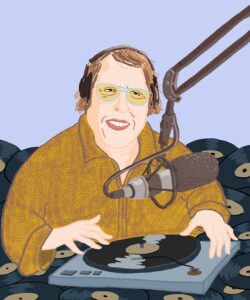
“We’d have conversations about the quality of the singers, if somebody was having vocal problems,” says Coral. Those phone calls were casual, not strategic, says Coral. “I did not have the faintest idea of joining the station.”
At the time, Coral was working in consulting and oncological research. When she retired in 2014, she moved to Eastham full-time. A year later, Weiner died. Coral called WOMR, concerned about the future of the shows he had established. Although she had never planned on becoming a DJ, she asked about the possibility of hosting. “One thing led to another,” says Coral.
Now she’s been a DJ for nearly 10 years for two shows: every other Monday from 1 to 4 p.m. she hosts Café Classicale, and she alternates hosting Opera House on Saturdays from noon to 6 p.m. Her co-hosts are Reed Boland on Café Classicale and Mary Jane Byrne on Opera House.
Opera House offers opera year-round: Mozart and Wagner and Bellini; American and European; canonical and lesser-known. On Café Classicale, Coral spins everything from Baroque to Romantic to modern music — symphonies, sonatas, and sarabandes. “Everything but atonal,” she says. “Atonal is hard to listen to.” Her approach to hosting is entirely ad-libbed — in her comments between pieces, she says, “I’m responding to the music, as I hope the listeners are.”
Coral’s love of music started with her parents. “I grew up surrounded by it,” she says.
“I’m not a musician,” says Coral, but she dabbled in learning a few instruments. “I had the requisite piano lessons. I enjoyed them, and I didn’t mind practicing. But I did not like recitals.” At Simmons University, where Coral was a student, “there was only a beat-up upright piano in the gym,” she says. “I let the piano go.” In the late ’80s she took flute lessons — an instrument of convenience — to maintain her ability to read music.
Every week, she spends about 8 to 10 hours curating her program by studying and listening to music. “Let’s say it’s the first day of spring,” she says — a hypothetical theme to shape a program. “I might choose Printemps by Debussy.” That symphonic suite was composed in 1887, when Debussy was living in Rome. In a letter home to Paris, the composer wrote of the piece, “I should like to express the slow and labored birth of beings and things in nature, their gradual blossoming, and finally the joy of being born into some new life.”
“What fascinates me is that music is a reflection of the politics and culture of the time in which the composer lived,” says Coral. Baroque music is generally agreeable and rule-following, although a particularly complicated fugue might set the listener on edge. “More contemporary composers like Shostakovich, Prokofiev — that music is disruptive,” says Coral. “I wouldn’t necessarily put on Shostakovich on a Sunday afternoon.”
More than anything, she finds music emotional. “It sparks a range of feelings, from extreme happiness and fulfillment to frustration or anger,” she says.
It also sparks nostalgia. Listeners often call in during her show. “They’ve usually either been musicians or they were opera fanatics when they lived in New York,” she says. “They’ll say, ‘I remember this!’ or ‘I saw him when he was a kid performing at Carnegie Hall.’ ”
Jay Stinson of East Sandwich is one of those engaged listeners. He turned 95 on Dec. 16 — the same date that Beethoven was born and the Boston Tea Party occurred, he notes. At age 12, he took a music appreciation class. The teacher played Edvard Grieg’s Peer Gynt suite. “I was swept away with the music,” says Stinson. “I’ve been in love with classical music ever since.” Like Coral, Stinson finds music emotional. “I still get chills listening to something I’ve heard 100 times,” he says.
Through calling in to WOMR, Stinson became friends with Weiner when he was host, and when Coral took over, the two also became friendly. They met in person for the first time at a matinee simulcast of a Met opera at the Cape Cinema in Dennis and became “fast friends,” says Stinson.
Stinson listens to WOMR’s classical and opera shows “religiously” and speaks to Coral every other week when she’s on air. “She has a great musicality about her,” he says. “She plays the regular war horses,” he says, but also “obscure things that I haven’t heard for years and years. I really appreciate that.”
Like Stinson, most of Coral’s callers are members of an older generation. Coral recognizes that classical music is considered by some an antiquated art form, but she’s optimistic about its continued relevance. On her show, she promotes concerts, especially at the local schools. “The community should go out and hear their kids perform and see what music can offer young people,” she says.
“In the time I’ve been here,” she says, “I’ve seen an increase in year-round musical activities related to classical music performance. While it certainly doesn’t attract the same kinds of crowds that pop and jazz do, it’s alive and well.”
As a DJ, says Coral, “I want to broaden people’s horizons.” Some might not choose to listen to classical music because they’ve never been exposed to it, she says. It has a snooty reputation, she adds. “Many people feel that they are held to a standard as listeners that they cannot achieve.” And some simply prefer other genres. “They’ll say, ‘I like jazz, but I can’t stand Chopin.’ ”
“Well,” says Coral, “jazz and classical music are very much interrelated.” She gives an example: the renowned American jazz and pop musician Quincy Jones was trained in Paris by the French music teacher, conductor, composer, pianist, and organist Nadia Boulanger. When asked what he learned from Boulanger, Jones said, “Counterpoint, structure, science, left brain.”
“Classical music is part of a continuum,” says Coral. “These different types of music are not necessarily mutually exclusive. Listeners can broaden their thinking and open their hearts and ears to different cultures through classical music.”
At the end of her allotted hours each week, Coral has one goal in mind: “I want them to feel the music,” she says.
ON THE AIR
The Art of the Interview
Ira Wood on crafting a ‘directed conversation’
There are four rules that underpin a good interview, says Ira Wood, host and producer of The Lowdown on WOMR. Maybe the most important one, he says, is this: lavish the person you’re interviewing with attention.
Wood says that it was his wife, the writer Marge Piercy, who gave him that insight. She told him, “Attention is love,” says Wood. “And in a strange way, an interview is like a very, very brief love affair.”
His on-air interviews — with thinkers, activists, and eccentrics of all kinds and lately nearly always writers — have included everyone from Indian-American physician, biologist, and author Siddhartha Mukherjee, whose most recent book, The Song of the Cell, won the Chautauqua Prize in 2023, to Heather Radke, who wrote a carefully researched cultural history of women’s rear ends called Butts: A Backstory.
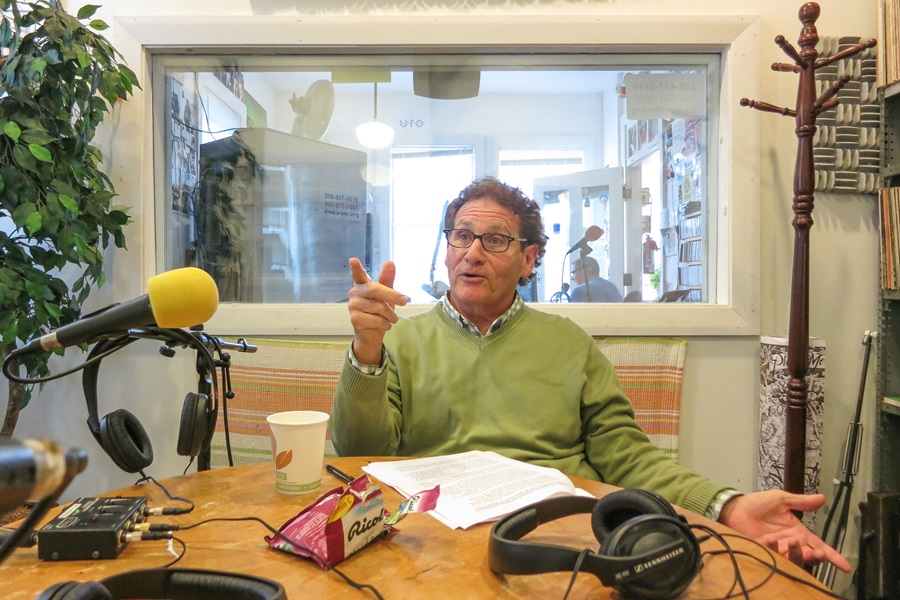
His other rules are to do your research (and for him that means reading the whole book); make a genuine connection with your guest; and be curious — no matter the subject of the interview.
Interviewing is not something Wood ever studied. “I’ve never read a book about it,” he says. Every interviewer develops his own method, he adds.
Wood admires Terry Gross — “She’s the best interviewer,” he says. But unlike her interviews on NPR, which get edited down for efficiency and clarity, Wood’s episodes are recorded live on tape. “What you hear is what you get,” he says. “Unless somebody has an enormous coughing fit, I will not stop the tape.”
Wood has learned to improvise. “I’ll come with a whole list of questions,” he says. “But sometimes I’ll ask question number one, and they’ll give me the answer to question number 10. Then it’s like, ‘What the heck do I do now?’ ” The rule doesn’t earn a spot among Wood’s four tenets of interviewing, but he mentions it anyway: “Be as prepared as you can, but then be ready for shit to hit the fan.”
Wood moved from Cambridge to Wellfleet 50 years ago to be with Piercy. “I was writing novels at the time,” he says. Cape Cod was an inspiring place to write, but the writing life was a lonely one. “The only thing I don’t like about writing,” says Wood, “is sitting alone and writing.”
Eventually he made his way onto the town’s zoning board of appeals, where he met people involved in town affairs, and “My world opened up.” He published a first novel, The Kitchen Man, and traveled around the country doing readings. Then, with Piercy, he started Leapfrog Press in 1997, but after selling it in 2007 found himself looking for something new to do.
“Somebody asked me if I wouldn’t like to do a show on town politics,” he says. His first show was called Outer Cape Debate. Wood seems to relish the memory of featuring the hot topics of the day: “There was a huge controversy about wind turbines. People were calling in and giving their opinions.”
But after about three weeks, Wood realized that not everyone he wanted to interview was going to travel up to Provincetown to talk with him. So, he switched gears: he started developing relationships with publicists at publishing companies. He reads a book every week and interviews authors of all kinds from all over the world: scientists, musicologists, sociologists, historians.
An interview isn’t just a conversation, says Wood: “It’s a very directed conversation.” In the 30 minutes he’s allotted for each show — “The gist of almost anything can be explained in 30 minutes” — he works to prevent the talk from going “all over the place.”
“Though I do allow people to hang themselves,” he says. But that doesn’t happen often, he adds. In fact, it’s mainly Wood who utters a controversial word every now and again — “There are certain words you can get away with,” he says.
Worse than a wandering conversation, he says, would be a boring one. But if that were to happen, it would be all his fault. On his own website, Wood writes, “There are no uninteresting guests or subjects, only unprepared and self-indulgent interviewers.”
As for questions, Wood writes his out. Sometimes a guest needs constant prodding. Then there are those who won’t stop talking. “I have become a total expert in listening to when people are taking a breath,” he says. When there’s a gap in their speech, he’ll insert the next question.
“The hardest question to come up with is the first question,” says Wood. “I put a lot of thought into those.” When he’s interviewing someone about a book, he’ll annotate the book in colored Sharpie, crossing things out, underlining, and making notes in the margins. The first question usually goes right to the main point of the guest’s work. If a lot of “throat-clearing” follows, “in other words, a lot of talk before they get to the meat of their answer,” Wood isn’t afraid to interrupt. From there he’ll work from question to question, trying in one half-hour to get the world to understand his guest’s story.
Wood is an egotist, he says, just like everyone else. “Sometimes I’ll interject something about myself,” he admits. But he tries to keep in mind a simple truth: “It’s not about me.”
A good interview resounds with that rule. Sometimes, says Wood, at the end of an episode, a guest, so in love with the intimacy of half an hour of undivided attention, won’t want to leave the studio. In those cases, says Wood, the station’s operations manager, Matty Dunn, will come in and rescue him.
When an author is in his studio or on the telephone with him, Wood is completely committed to that person. But once the interview is over, Wood says, it’s as if his guest is gone forever. He’s not the only interviewer this happens to. “An old friend who had a show on NPR many years ago told me that when he ends an interview, the thing disappears,” he says. “It doesn’t exist. He said, ‘They’re just a fart on the wind.’
“If you ask me next week who I interviewed today, I really won’t remember,” says Wood. “It’s like, I gave it everything that I had. And then I’m on to the next.”
RADIO WAVES
From Mount Gilboa to Your Car: a WOMR Journey
Age, salty air, and an electrocuted bug motivate the search for new transmitter
PROVINCETOWN — Atop Mount Gilboa, perhaps more dune than mountain, sits a large light blue water tower whose paint has begun to fade and flake. A radio antenna sticks out from its roof and a thick black cable snakes down toward a small shed in the structure’s shadow.

The shack, home to WOMR’s radio transmitter, is objectively unsexy, according to the station’s part-time broadcast engineer, Chris Kelly. It’s the type of place where extended stays are probably an indication that something has gone awry, like now.
WOMR’s transmitter has been coming up short. The device is broadcasting at around 2,600 watts, well short of the station’s licensed 6,000. Less power means less range. Several factors have contributed to the decline, notably its age, but one incident provided the largest shock — pun intended.
After a meeting in Truro last summer, WOMR Executive Director John Braden heard dead air on the radio and headed straight to Mount Gilboa. Inside the shack, he “smelled a burning.” Braden, with Kelly’s help, later discovered that a bug had snuck into the transmitter, possibly attracted by the heat it gives off, and electrocuted itself.
The result was frazzled circuitry throughout the device.
The transmitter has not been able to recover from the encounter, although Kelly, who works full-time for WGBH in Boston, noted that the larger long-term factor is the damaging “caustic air” from the ocean. Kelly and the machine’s manufacturer later decided a replacement was necessary. It will cost $135,000.
The Radio Process
The Mount Gilboa transmitter, which lives a little over a mile from the WOMR studio on a service road off Route 6A, is one of the last stops on the sonic journey from the station to your car’s radio.

The path begins in the studio, where the station’s volunteer DJs have a variety of options when it comes to producing sound. From microphones to record players, all are routed through the mixing board.
Between three and four dozen wires connect the studios to the building’s attic, said Braden. That “spaghetti” eventually reaches a small transmitter on-site from which the signal is ferried along more wires into a dish in the station’s bell tower. It then beams the broadcast using microwaves to a receiver located on top of the unsexy shack.
That initiates a similar transfer process on Mount Gilboa, where the signal travels through a second larger radio transmitter — which amplifies the audio signal to 6,400 watts — and directs it through “super heavy duty” wiring to the top of the water tower antenna. Along the way, it loses 400 watts, bringing it in line with licensing requirements. The signal is then finally sent out into the atmosphere as radio waves.
If the process sounds elaborate, with the potential for technological breakdowns and other complications, that’s because it is.
“All the elements here are like different roads converging onto a highway,” said Chris Boles, the WOMR office manager. “You learn over the years what each component does and how each component can break down.”
Boles would know. He’s been in radio since graduating from high school, when he told the program director at the local station in Orleans that he’d do “anything he had.”
The assignment was a midnight to 6 a.m. shift. Boles claimed that he never fell asleep, despite coming close “a few times.” But he added that his late-night radio compatriot in Hyannis — the only other station on the Cape broadcasting during the early hours at the time — couldn’t say the same.
“He would fall asleep periodically,” said Boles. “I would find out because I would get calls from his listeners saying, ‘Well, Rich fell asleep so I’m listening to you.’ ”
The Push for a New Transmitter
The insect incident was not the first time a critter damaged a transmitter (Boles recalled previous engineers returning to the studio holding electrocuted mice by the tail), although it may be the last.
As of July 8, Braden said WOMR had raised over $40,000 toward its goal. The station has already ordered a replacement transmitter to avoid the current one’s premature failure and expects to install it sometime after Labor Day. The shack will also be “weatherized” to protect it from the seaside air — and pests.
It is another lesson learned for Braden, who began his career at WOMR as a volunteer in 1991 after moving to Provincetown at age 30. He was still the operations manager when the current transmitter arrived 15 years ago. A half hour tutorial was all he got when the system was installed.
“I had no training in this,” said Braden. “Before I moved here, I was a truck driver. You gotta do what you can with what you got, until somebody who can help you comes along.”
Asked if he would be sad to see the classic go, Kelly said he was excited about the upgrade. “It’s a box that makes radio,” he said, adding that the new transmitter is “a very slick box.”
“It’ll email you,” he added. “It tells you how it’s feeling,” which should avoid any nasty surprises in the future.
RADIO
Matty Dread Is an ‘Ambassador of Love’
Meet the man who keeps WOMR spinning
Matthew Dunn, the operations manager at Provincetown’s Outermost Community Radio (WOMR), has waist-length dreadlocks and wears galaxy-print shirts. Both amplify his gravitational pull.
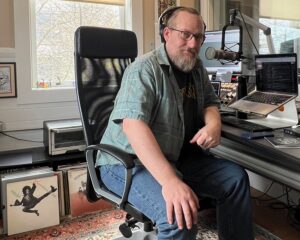
In his corner office at 494 Commercial St., he engages a visitor the same way he does his radio audience, offering an immersive auditory experience. He talks in a warm, deep voice punctuated by the staccato cadences of something like Beat poetry — free-flowing and intent on bucking convention.
Dunn has been with WOMR since 2002, when the station lived in a condo on Center Street. He started out as a DJ on the midnight to 3 a.m. graveyard shift. Supporting himself with various side hustles — tending bar, waiting tables, and DJing for weddings — he worked as a volunteer for 10 years before becoming the full-time operations manager in 2012.
Dunn introduces himself as Matt, but most people know him as Matty Dread. The nickname predates his time on the radio; he got it at the University of Vermont where, immersed in the reggae of the late 1980s, he decided to “go dread.”
“I was a young hippie with an Irish afro,” he says. “I was never seriously into Rastafarianism, but my hair represents my commitment to breaking down cultural norms. At this point I think I would still be Matty Dread even if I cut my hair or it all falls out.”
Dunn hosts the blues show Morning Madness on Wednesdays from 5 to 6 a.m. and The Soul Funky Train on Thursdays from 1 to 4 p.m. On any given Thursday, a listener might follow him through a playlist of jazz, hip-hop, rock, reggae, and soul, held together by the fiber of funk that Dunn threads to connect them.
“The vast majority of the time I’m playing music that I suspect most people will never have heard before,” he says. He thinks listeners get more joy that way. “But I do try to provide a few signposts along the way. I’ll throw in Aretha Franklin or something because it helps put everything else in context.”
Dunn was born and raised in Syracuse, N.Y., studied philosophy in college, and moved to Cape Cod in the early aughts with his wife, Beth, who grew up here listening to her father, Jim Mulligan, on his long-running WOMR show, Mulligan Stew. Now, Beth and Matty co-host the station’s Outer Cape News show every Friday afternoon. Matty drives to the studio in Provincetown from their home in Dennis at least once a day, sometimes more, depending on need.
DJing is just one part of Dunn’s job. “My real job is making sure the radio stays on,” he says.
“I ask Matty technical questions often,” says Denya LeVine of Wellfleet, who has been a WOMR DJ since 1985. “He put together a manual that you can look at for almost anything you need to know.”
In addition to making the schedule and providing tech support, Dunn trains and manages the 100 or so DJs who sustain the station’s programming across a wide spectrum of genres. “It’s eclectic: bluegrass, funk, opera, folk,” he says.
“Matty is constantly trying to bring new voices to the station and weave a fabric that reflects the Outer Cape,” says Mike Fee, who lives in Truro and hosts Road Trippin’ — a three-hour journey through classic and contemporary blues, rock, soul, and funk on Thursday mornings. “I started calling him the ambassador — he is truly the ambassador of love.”
That diplomatic spirit helped Eric Auger feel welcome when he joined the station last year as a substitute DJ after moving to Provincetown during the pandemic. He says Dunn’s trust in him helped him feel that he had found a home at WOMR.
Each time he has presented a new idea — from pitching his show The Reminiscence Bump, in which Auger relates memories from his life and plays the songs attached to them, to holiday-themed sets like a Halloween vampire radio hour — Dunn has been all ears. His approach is “Okay, let’s see what you can do,” Auger says.
Dunn’s DJ diplomacy also includes visiting Outer Cape schools to teach kids about radio and making house calls to collect donations from listeners who want to offload their analog music collections of cassettes, CDs, and vinyl.
He assesses the value of these donations and sells them on Discogs, a type of eBay for music collectors. The proceeds of the sales go to WOMR.
Until they are sold, most donations get stored in Dunn’s office. Two floor-to-ceiling bookshelves packed with vinyl climb one wall on either side of a large window above a sun-bleached red carpet. There are cassettes on one desk and CDs on another.
From a different pile, Dunn picks up Woyaya, a 1971 album by the London-based Afro-rock band Osibisa. “I just discovered them,” he says, beaming like a kid with a brand-new toy.
Posters of Earth, Wind & Fire and from the New Orleans radio station WWOZ guard the desk, which is populated with a soundboard, microphone, and four monitors that Dunn constantly works.
Above all of this, there’s also a scrap of paper on the wall, penned by the musician and WOMR board member Barbara Blaisdell, that frames Dunn’s commitment to the station in black and white: “I pledge allegiance to WOMR and to the programming for which it stands: one station, on Cape Cod, transmittable with melody and substance for all.”
Dunn is quick to note that he is just one voice of many. “None of this happens without everybody working together,” he says.
“I want to be able to have WOMR be a safe space for me to do my thing and to create that space for other people to do it, too,” says Dunn. “It started with just hippies and beer and borrowed space. More than 40 years later, we’re still here to provide a platform for members of the community to express themselves.”
THE BEAT
Sam Holmstock Helps Veterans Drum Through Their Trauma
How one WOMR DJ teaches the healing art of drumming
HYANNIS — Sam Holmstock lives in Cotuit, but he doesn’t mind his once-a-month commute to Provincetown. On the second Sunday evening of each month, Holmstock hosts his WOMR radio show Africa Oye, which features Afropop — music from Africa and the African diaspora, including Cuba, Jamaica, the Dominican Republic, and Haiti, that is deep with drum grooves.

When he’s not DJing, he’s drumming. Earlier in his career, Sam was one of the founding members of the Martha’s Vineyard band Entrain, which plays a “funky-world-mam-ska-reggae-rock stew.” Now he plays with Bongo Genesis, which he says is “a Buena Vista Social Club kind of thing.”
Holmstock is also the founder of Drum Strategies for Healing, which brought a drum circle to the Hyannis green on Sept. 10 in recognition of National Suicide Prevention Month. The circle was hosted by Veterans for Peace, an organization whose mission is to increase awareness of the true costs of war — one of which is suicide among those who have served.
Holmstock did not serve in the military himself. But his brother Stephen has, most recently in Afghanistan and Iraq. Stephen left the military with a severe case of PTSD. It was concern for his brother, and for older relatives who brought psychic scars home from their service in Vietnam, that inspired Holmstock to refocus his musical career from playing for fun and profit to playing to heal the invisible wounds of war.
The idea of using African styles of drumming to mitigate the effects of trauma took shape after Holmstock was invited to teach drumming to dementia patients at the Atria nursing home in Falmouth. There he observed that the experience of drumming seemed to mitigate patients’ symptoms of dementia, at least for a short time. They enjoyed drumming, and it helped them remember and sing songs they used to know.
After finding some promising research on drumming’s positive effect on people with PTSD, Holmstock started his “Drumming Through Trauma” class for veterans at the Cotuit Center for the Arts.
This writer, also a veteran, joined that Sept. 10 circle on the green in Hyannis. After we hung ribbons to honor the memory of fellow veterans who have died by suicide, Holmstock focused the group on how to produce rhythms on an African drum. In the process, the somber mood of the morning was changed to one approximating peace.
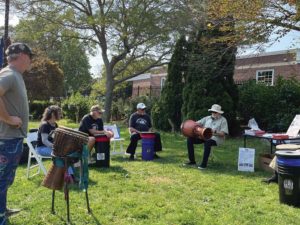
The first thing Holmstock explained was the relationship between the hands and the drum, namely what part of the hand should strike what part of the drum to produce a particular sound. Then he demonstrated, using simple phrases, how to generate rhythms of six or seven beats. We found ourselves chanting “peanut butter sandwich” and striking a different part of the drum with a different part of the hand on every other beat to generate a regular rhythm.
Once one simple rhythm was established, we learned variations with the same number of beats. Half the circle then played the first rhythm while the other half played the second as a counterpoint. It sounded as if the two rhythms were speaking to each other.
Because the rhythms were sustained by the repetition of simple phrases that we could repeat softly under our breaths as we played, it was possible to sustain the drumming for 10 or 15 minutes at a time, long enough to fall into a meditative state.
After we emerged, Holmstock talked about one of the most difficult challenges he encounters when working with veterans.
“I would like to be connected to Wounded Warriors, for example, and other groups established to support younger vets,” he said. But it’s hard to get younger vets involved. “All the post-9/11 guys are reluctant to admit their trauma.”
Most members of Veterans for Peace openly recognize their wounds and speak of the danger of ignoring them. That’s because they have “a certain distance and wisdom born of age,” said Holmstock.
There are others who could benefit from drumming, Holmstock said. In the early spring of 2020, he got a grant to work with incarcerated veterans in Barnstable County, but the pandemic “stopped that effort in its tracks,” he said, when no one was allowed to visit the jails. In June, Holmstock ran a four-week drumming program at Wellfleet Preservation Hall. Sponsored by Helping Our Women, it was open to all; some 10 to 15 drummers joined in each week. He also runs an African Drumming Class on the Hyannis green every summer.
“Drumming,” Holmstock said, “is for folks who are healing.” It does not cure, he said, but it does move people forward.
Sam Holmstock’s band, Bongo Genesis, will be at the Cotuit Center for the Arts on Oct. 7.
RADIOHEAD
Billboard Bob Takes Listeners on a ‘Charted Course’
His show on WOMR tracks time through music
An accountant and father of two, Bob Galvin, 67, leads a quiet, unremarkable life with his wife in Plymouth. That is, until you get him talking about music. Then his superpowers come out.
For 25 years, Galvin has had a radio show on Provincetown’s WOMR called Charted Course that delivers Top 40 hits from the 1960s through the 1980s. He arranges every one of his shows around Billboard charts. Sometimes, he simply plays the top 40 songs from, say, 1975. But his encyclopedic mind often creates more complex combinations.
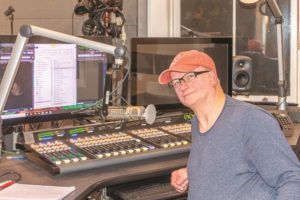
On a recent Thursday, for example, he played 35 songs from 35 years. The common thread? The order in which he played each tune matched its peak position on the charts for that year. The first song on his show was number 35 when it reached its top position, the following was number 34, moving all the way to number one.
Galvin’s playlists, being oft-played pop hits, are familiar to most of us. But the way Galvin puts them together adds layers of nostalgia, harkening back to the soundtrack of one’s life at a certain time. Anticipation builds over the three hours of Charted Course as you try to guess the next song. Since Galvin’s choices usually move from the lowest on the charts to the highest, listeners expect each song to get progressively better.
John Braden, WOMR’s executive director, said that Galvin has a “savant-like” ability with numbers. “That is my disease,” Galvin jokes. He has the same prodigious memory when it comes to baseball statistics and Oscar-winning movies.
Galvin’s musical passion started with Casey Kasem’s Top 40 show, which hit the Boston airwaves in 1970. Galvin was a teenager living in Dorchester. He would go to Harvard Square each week to buy the newest issue of Billboard, the official record of the weekly Hot 100 hits. He kept notebooks (now thrown away) to track the songs as they moved up and down.
“It’s funny, because I do accounting, and it’s sort of incorporated into my methodology,” he said. “Basically, I was doing accounting before I even knew what accounting was.”
At one point, Galvin owned about 2,000 compact discs and vinyl records. Now much of his collection is stored on his computer. He also owns numerous books on Billboard charts, many by Joel Whitburn, the leading authority on the subject. Galvin has absorbed all kinds of musical trivia that make for juicy anecdotes on the show.
Despite this teenage passion, Galvin never wanted to be a professional disc jockey.
Frank Foley, a former WOMR DJ known as Captain Frank, the host of Root Soup, recognized Galvin’s superpower and came up with his radio name, “Billboard Bob,” in 1995. At the time, both worked at the Sheraton in Eastham, where Galvin was an accountant. Foley invited Galvin on Root Soup as a guest. His entertainment value was immediately obvious.
The following year, Billboard Bob began his own show on May 30. There’s no doubt that date is right, as he has kept 14 notebooks that contain “every single song I’ve ever played” on every show.
Galvin said he can put together a show in one hour, though it usually takes a lot longer to listen to and savor each song. He called the Saturday ritual of creating the show “one of the most fun things I do.”
To test his knowledge, the Independent asked him what tune was No. 1 in June 1975. Bob thought about it for a second. At first, he came up with the top song in July of 1975: “The Hustle” by Van McCoy. He explained that there were 35 No. 1 hits in 1975, quite possibly more than in any other year.
This led Bob into a discussion of the Thriller album by Michael Jackson. It produced seven hit singles, he said.
But getting back to June 1975, Billboard Bob finally said, “I believe that, in June, ‘Love Will Keep Us Together’ by the Captain & Tennille was number one for four weeks and the number one song for that year.”
Galvin’s recall is impressive, but he is also forthcoming about his personal tastes. His favorite musical era? It was 1966 to 1975. Favorite song? “The Story in Your Eyes,” by the Moody Blues, which is his favorite band, followed in no particular order by the Beatles, Simon & Garfunkel, Tom Petty, Alice Cooper, Led Zeppelin, the Rolling Stones, and “I could go on and on,” he said.
If you want to hear more, Billboard Bob’s Charted Course is on the air every Thursday from 5 to 8 p.m. on WOMR, 92.1 on the FM dial.
Virtual Verse
Join Wellfleet Preservation Hall and WOMR for a virtual poetry reading with the winners of the Joe Gouveia Outermost Poetry Contest: Rosemary Dunn Moeller, Michael Shapiro, Wilderness Sarchild, J. Lorraine Brown, Dianne Woods Ashley, James S. Cornell, Judith Partelow, Wayne Miller, Ginia Pati, and Rose Auslander, and contest judge Marge Piercy. It will take place Thursday, April 29th, at 7:30 p.m. Email [email protected] for the Zoom link.
RADIO
Meet the Women DJs of WOMR
The station will host its annual International Women’s Day marathon
WOMR’s International Women’s Day celebration began in 1988, says Denya LeVine, one of its “founding mothers.” But only in the last 10 years has the station been doing it consistently, every year. On Monday, March 8, 16 female DJs will bring you 18 hours of music and thought-provoking interviews. The Independent visited five of them to talk about their experiences on radio.
Indira Ganesan
“I had trouble making myself understood — that’s why I took to writing,” says Indira Ganesan, who was born in India and moved to the U.S. when she was five. She has since published three books. Ganesan first came to Provincetown as a fellow at the Fine Arts Works Center in the ’80s. She’s been living here full-time for eight years, with her two cats. “It’s a quiet life,” she says.
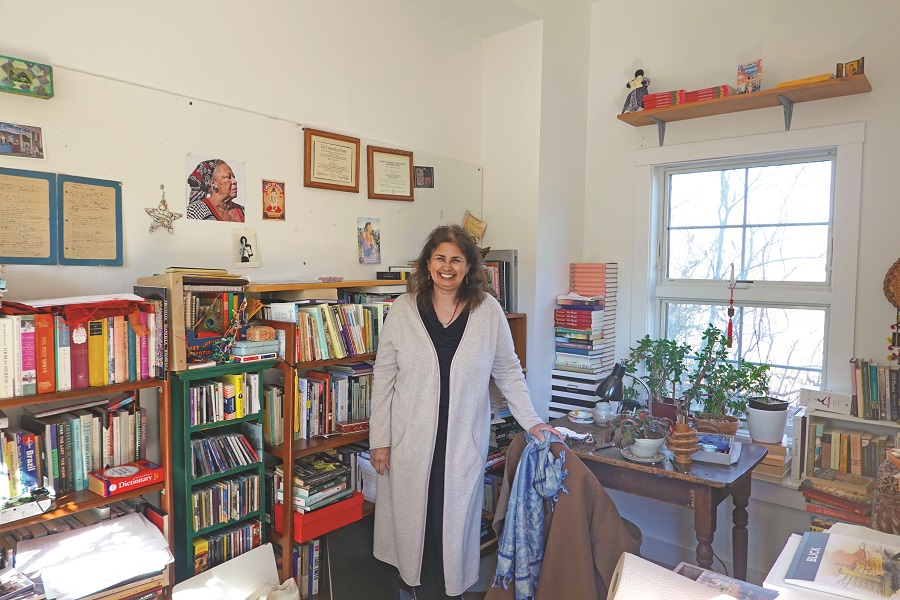
She has always been a “record nerd” and listened to the radio — “Music was this constant” in her life. South Indian and North Indian music are really different, she explains. As a child, she found the former “terribly boring,” but was introduced to the sitar, a North Indian instrument, by the Beatles. Her radio show, Namaste, includes all kinds of global and popular music.
She says that though there is no lack of female DJs at WOMR, there are too few elsewhere in the country. One of the earliest was Alison Steele, on WNEW-FM in New York City, known for her sultry voice. Part of the bias in broadcasting, Ganesan says, may be the stereotype that women are shrill. And so, it is assumed, “Do people really want to hear women and their voices?”
Felice Coral
Felice Coral’s regular WOMR program on Wednesdays focuses on classical women composers of color, both historical and contemporary: Florence Price, Margaret Bonds, Julia Perry, Tania León, and Valerie Coleman. It’s a tall order to pack all of it into one hour, Coral says.
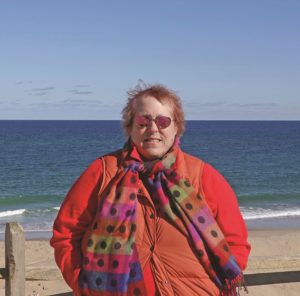
“I had to admit my own deficiencies even as a long-established classical music lover,” she says. “We’re raised in the white Eurocentric framework.” Price, for instance, was a Juilliard-trained pianist and composer, but has fallen into near obscurity. “There’s the overall sexism, and then, superimposed on that, there are the racial issues,” she says.
Coral, who has lived in Eastham for the last six years, previously worked in health care. She played piano and listened to opera growing up, but let her musical interests drop because she was working all of the time. About 20 years ago, she started taking flute lessons.
“I enjoy doing my shows because I also learn a lot,” she says. “It has enriched me as an individual. Putting this program together has opened my eyes significantly to the successes of people I knew nothing about.”
Denya LeVine
A WOMR DJ for 35 years, Denya LeVine, along with Pandora Peoples and Dinah Mellin, are the organizers of the International Women’s Day marathon. LeVine started studying violin at the age of nine, and plays Celtic, folk, and klezmer music with several bands. She is also passionate about playing in assisted living homes.
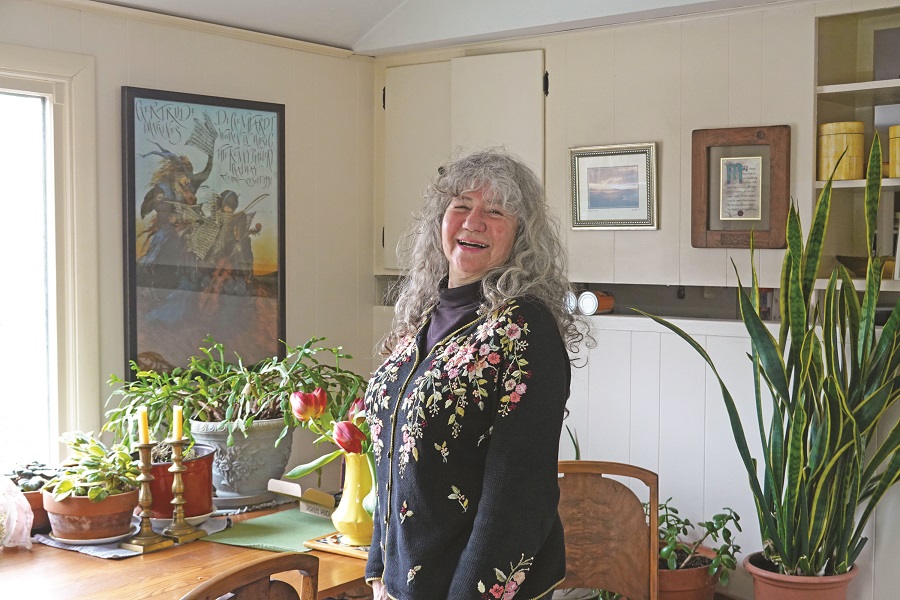
Though she’s not Irish — “I’m Eastern European Jewish,” she says emphatically when asked — she’s spent a great deal of time in Ireland, a homeland of sorts. In the first two years of International Women’s Day broadcasts at WOMR, she organized a live feed from a women’s pirate radio station in Galway.
This year, she interviews Karan Casey, “one of the best-known Irish singers,” who started the organization Fair Plé to address gender equality, the pay gap, and sexual harassment in Irish music. LeVine says the scene was heavily male-dominated, but “the organization ended up changing the culture.”
Pandora Peoples
“I was born in Venice, Calif., in a bungalow to hippie parents,” says Pandora Peoples. She came to Cape Cod 10 years ago. She’s a shamanic healer, herbalist, and belly dancer, and her weekly radio show focuses on healing arts and metaphysics.
In her programming, she looks to “matrilineal cultures, goddess cultures, and priestesses,” she says. “International Women’s Day is another opportunity to reclaim some kind of power. There are a lot of activists at WOMR. People’s rights, earth rights — it drew me in.”
For Peoples, International Women’s Day is “about telling local stories.” One example is Dinah Mellin’s interview with Lysetta Hurge-Putnam, executive director of Independence House in Hyannis. “We have really great infrastructure,” she says. “I appreciate that about this place.”
Dinah Mellin
On her radio show and in live performances, Dinah Mellin plays Celtic and fiddle music. She used to run a program through Snow Library called “Allegretto,” which introduced children to different musical instruments. The goal was to tell them, “This is for everybody — this is a friend for life.”
She was brought up in “a house of music,” she says. “I grew up in Manhattan. My dad had a ministry downtown. That’s where I had my first lessons around age nine.” Her mother composed and played the piano.
She studied studio art, then commercial art and advertising. “I didn’t play for 13 years after graduating from college with an art degree,” she says. “I was walking around feeling like I was missing an arm or a leg.” Then she started fiddling again.
Mellin doesn’t consider herself “the biggest feminist in the world.” But, she says, “I am a feminist because I believe in women’s rights.”

Women on Air
WOMR, 92.3 FM, Monday, March 8
6–8 a.m.: Justine Alten, “Women of Red Right Return”
8–9 a.m.: Fran Sullivan, “Gospel and Blues”
9–10 a.m.: Ann McDermott, “Cool Voices of Jazz”
10–10:30 a.m.: Interview with Sheila Lyons
10:30–11:30 a.m.: Susan Blood, “Stories From the Sisterhood”
11:30 a.m.–noon: Mary Jane Byrne, “Sopranos, Mezzos, and Contraltos”
Noon–1 p.m.: Felice Coral, “Classical Composers: Women of Color”
1–2 p.m.: Ashley Stancil, “Women I’d Like to Lunch With”/Interview with Kathleen Walker
2–3 p.m.: Carol Courneen, “Rootsy Women”
3–4 p.m.: Janice Murphy, “Women on Broadway”
4–5 p.m.: Democracy Now, with Amy Goodman
5–6 p.m.: Denya LeVine, “Gender Equity in Celtic Music”/Interview with Karan Casey
6–7 p.m.: Pandora Peoples, “Music for Social Justice”
7–8 p.m.: Brenda Conlan, “Hopeful Tunes by Women”
8–9 p.m.: Indira Ganesan, “Namaste Celebrates Women”
9–10 p.m.: Nancy Edwards, “Soul Sisters”
10–11 p.m.: Sandra H-Mc, “Spotlight on the World”
11 p.m.–midnight: Dinah Mellin, “Celtic Music”/Interview with Lysetta Hurge-Putnam
INJUSTICE
After 7-Year Legal Fight, Porter Gives Up P’town Home
WOMR’s ‘Lady Di’ will keep singing from Sandwich
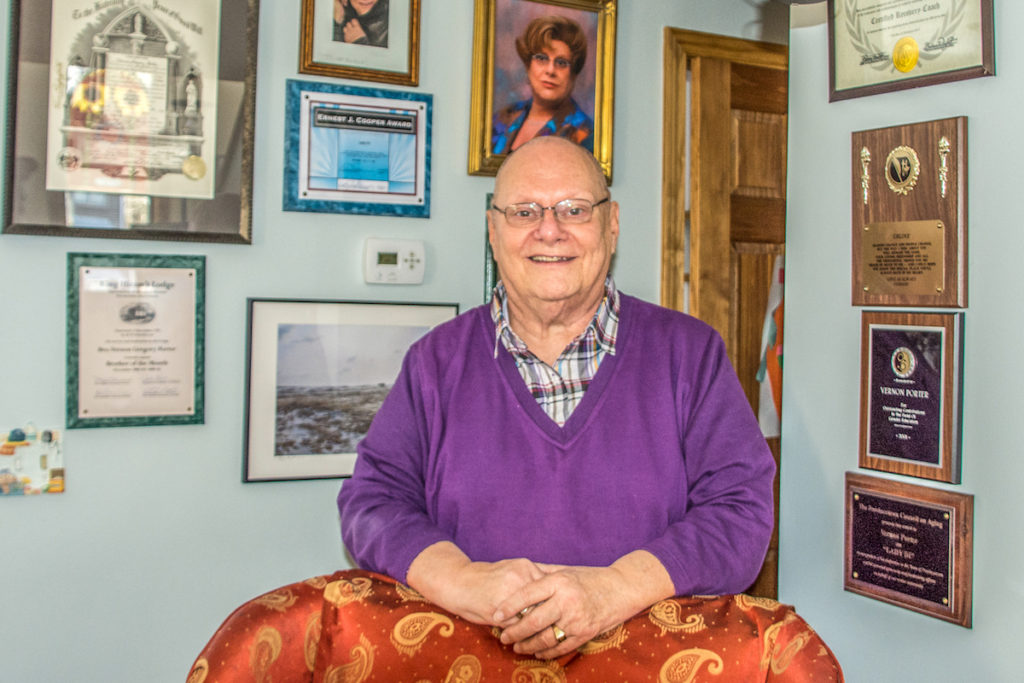
PROVINCETOWN — Vernon Porter, the irrepressible “Lady Di” of WOMR-FM’s most popular show, Friday night’s Leggs Up and Dancing, has been forced to give up his home in Provincetown.
It’s now been seven and a half years since Porter resigned his job as the secretary for the Provincetown Board of Selectmen and filed a disability claim, presenting evidence that a hostile environment at town hall had made him so sick he couldn’t work. The selectmen at the time and the Barnstable County Retirement Board denied Porter’s claim.
A series of appeals ensued, and Porter’s right to a modest retirement pension, estimated at about $20,000 a year, was ultimately affirmed in Superior Court. The retirement board, on the advice of its attorney James Quirk of Hyannis, took the case to the state Appeals Court, which, after a year, remanded it to the Contributory Retirement Appeal Board (CRAB).
And there it has sat for the last 21 months on the desk of an assistant in Attorney General Maura Healey’s office. Porter’s lawyer, Bruce Bierhans of Wellfleet, called the saga “one of the worst examples of government delay I’ve ever seen.”
According to Bierhans, Porter is entitled to retroactive disability benefits totaling about $150,000 at this point. But lack of funds led him to move on Saturday into a condo on Highview Drive in Sandwich, 59 miles from Commercial Street and Lady Di’s beloved radio station.
“Moving in to my new condo tomorrow,” Porter wrote to his friends last Friday, “but I am sure I will be visiting Ptown quite often. Have wedding booked already in 2021.”

Porter officiates at weddings as a minister of the Universal Life Church, an activity that got him in trouble with town officials when he worked for the selectmen.
“They accused me of doing weddings on town time and cheating the town out of money,” he told the Provincetown Banner in 2018. “I never did that — absolutely not.”
Porter’s disability claim was upheld in a February 2018 ruling by Superior Court Justice Cornelius J. Moriarty II. The court relied in part on the findings of a three-person panel of cardiologists and a separate three-person panel of psychiatrists. Both panels were unanimous in judging Porter to be permanently disabled and agreeing that the town hall work environment “might have contributed to or resulted in the disability,” Moriarty wrote.
The County Retirement Board appealed the decision in March 2018.
“We lost about 14 months because of the board’s frivolous appeal,” said Bierhans. “Since it went to the attorney general’s office, they have done absolutely nothing.”
On Feb. 9 Porter received a letter from Assistant Attorney General Uyen M. Tran in response to his request for information about his case.
“When I took on this role as Chair of CRAB back in July 2019,” Tran wrote, “it was my goal and still is my goal to address the pending appeals at CRAB. However, the onset of Covid-19 has made this goal very challenging to say the least. Further complicating matters is the fact that the designee from the Department of Public Health (DPH) who presides over disability retirement matters, resigned from the Board in order to focus her attention on this public health emergency. In light of these circumstances, CRAB has not been able to address disability retirement matters.”
In a Feb. 15 response to Tran, Bierhans wrote, “CRAB has had the case on remand since May 10, 2019, well before any pandemic related shutdown. … I cannot imagine that this case could not have been concluded by now had the will been there.”
A voicemail message left on Tuesday for Tran was not returned by press time.
Porter said that, thanks to WOMR’s John Braden, Lady Di would continue to do her weekly program remotely from her new home in Sandwich. “This makes me very happy,” he said.
Braden confirmed that he and the station’s engineer would be meeting with Lady Di on Sunday to test equipment that will make broadcasting from home possible, a new capacity for WOMR. “Hopefully, it will be plug and play,” said Braden, “so she doesn’t need a technician.”
He noted that Lady Di is the all-volunteer community radio station’s most effective fund-raiser.
“After 21 years in Provincetown,” Porter wrote in his message to friends, “I was sure this would be the last place I ever lived. However, circumstances were such that I was left no choice financially but to sell and leave Paradise. If I ever get my disability pension, who knows, I may be back.”
Hilary H. Bamford, 83, Host of Friday Folk
Hilary H. Bamford of Provincetown died at home on Jan. 19, 2021 at age 83 after a lengthy illness. She was the widow of Sidney W. Bamford, who died in 2003.
Born in Canajoharie, N.Y., she was the daughter of the late Newton and Annette Herrick. She attended Boston University.
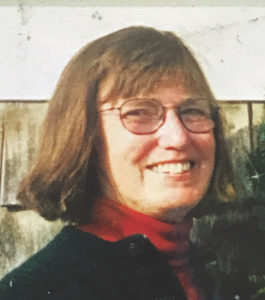
In the late 1950s, Hilary moved to Provincetown, where she was active in town affairs for years. She was a founding member of the Friends of the Provincetown Library, and was a member of the Provincetown School Committee, the Cape Cod Technical High School Committee, and the Cape Cod Collaborative. She was an antiques dealer specializing in ephemera and old postcards and was a founding member of the Cape Cod Postcard Collectors Club. She contributed illustrations to the Provincetown Methodist Church cookbook and made linoleum block print Christmas cards featuring family and local scenes.
For 30 years, Hilary hosted The Friday Folk Show on WOMR-FM, playing the rockabilly music of Brian Setzer, Steve Earle, Johnny Cash, Emmylou Harris, and others.
She proudly raised funds for the radio station by redeeming five-cent bottles and cans and, said WOMR’s executive director, John Braden, “did a whole lot more,” picking up the station’s mail each day, bringing its recycling to the dump, and hosting an annual yard sale in its honor.
She was computer-free and fiercely independent. Hilary described herself as a Democrat, anti-nuke, a peacenik, and a recycler. She enjoyed the New York Times crossword puzzle and Nordic Noir mysteries.
She is survived by her sons, Christopher Caldwell and wife Judith of Northborough and Timothy Caldwell of Sarasota, Fla. She also leaves sisters Fernanda Fowls and husband Steve of New Jersey, Polly Foley and husband Frank of Eastham, and Tina Culver of Owls Head, N.Y. Stepchildren Thaddeus Bamford and wife Brenda of Washington state and Tabitha Bamford and husband Jason of Oregon also survive her.
Memorial donations in Hilary’s name may be made to WOMR, Box 975, Provincetown 02657 or to VNA Hospice, 255 Independence Way, Hyannis 02601.
Expressions of condolence for the family may be left in the guest book at gatelyfuneralservice.com.
Coffeehouse at the Mews Goes Virtual
Coffeehouse at the Mews is celebrating its 30th anniversary. But this year, it is going virtual. Watch Mondays at 7 p.m. via Facebook or YouTube.
Presented by Live From Provincetown, the virtual coffeehouse will be hosted by Ron Robin and Peter Donnelly. It will feature guest musicians and poets to be announced each week. Donations will support Coffeehouse at the Mews, WOMR, and Provincetown Theater.
